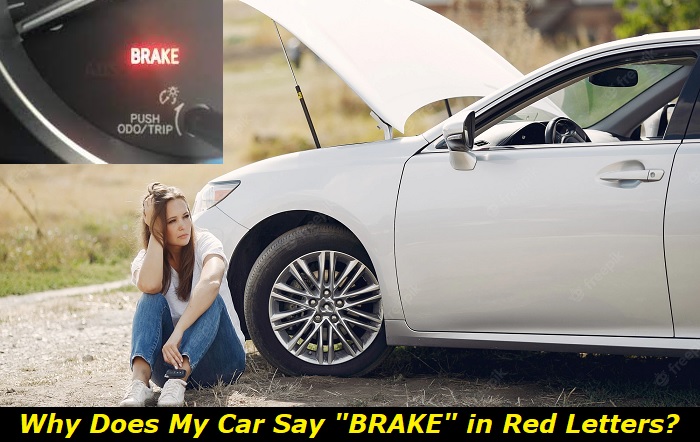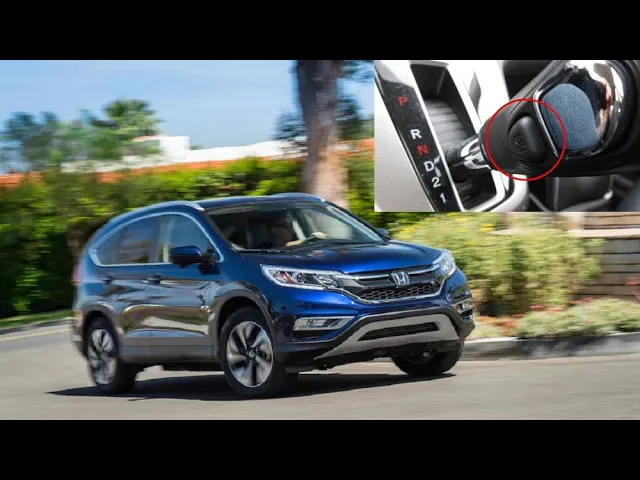There are many different warning lights that can light up on your dashboard. While none of these warning lights should be ignored, certain lights are more urgent than others. Any sort of brake warning on the dashboard needs to be addressed immediately. But what does it mean when you see "BRAKE" on your dashboard in red letters?
When your car says "BRAKE" in red letters on the dashboard, your car is alerting you to the condition of the brake system. To be more specific, it indicates one of two scenarios. One is that you're driving with the parking brake engaged. The other is that there's a problem with the brakes, particularly that the brake fluid is low.
In this article, we'll look at what to do when your car says "BRAKE" on the dashboard in red letters. We'll also discuss how you can determine the cause of this warning, and what needs to be done to make it go away.

What Does a Red "BRAKE" Warning Mean?
When the red "BRAKE" warning appears on your dashboard, it's informing you that there's an issue with the car's brake system. This usually points to one of two issues, which can make it hard to determine where the problem is coming from. However, in most vehicles, the dashboard will also display a second light that is more specific about the problem.
The first light is a red circle with the letter P inside of it. This light indicates that the parking brake is partially or fully engaged.
The second light is a red circle with an exclamation mark inside of it. This light indicates that the level of brake fluid in the master cylinder is too low.
Keep in mind that the brake warning indicator is different on all vehicles, and these warnings could show up differently on your own vehicle. However, in most instances of the red "BRAKE" light appearing on the dashboard, these are the two main causes of the problem.
Is it Safe to Drive With the "Brake" Light on the Dashboard?
It is not safe to drive when this warning appears on the dashboard. It indicates that there is a problem with the brake system that needs to be addressed promptly. When this light is on, your car's braking power might be compromised. Your brakes may not be as responsive as they usually are, which is very dangerous in the event of an emergency.
it is very important to know what to do if this warning appears on your dashboard, especially if this happens while the car is moving.
What Should I Do if "BRAKE" Appears on My Dashboard?
A sudden brake warning can be a very scary thing to see on your dashboard. Knowing how to handle the situation safely, especially if it occurs while you're on the road, is very important.
If this warning appears on your dashboard before you've started moving the car, then you shouldn't start driving. The first thing you should do is make sure that the parking brake is not engaged. If disengaging the parking brake removes the warning light, then you can continue to drive.
However, if disengaging the parking brake does not remove the warning light, then you will need to examine the brakes.
If the warning appears on your dashboard while you're driving, you need to stop driving as soon as you can. Slow down the vehicle and pull over as soon as it is safe to do so.
Once you've parked the car, you should check the parking brake. If the parking brake is partially engaged, then you should disengage it and see if that removes the warning. if disengaging the parking brake does not remove the warning, then you will need to inspect the brake system.
How to Stop the Car if the Brakes Aren't Responding
Your car has two hydraulic systems that control the braking for two wheels each. This allows for a level of redundancy that allows the car to brake even when there is a problem with the brake system. The brakes will work more slowly than they usually do, but you should still be able to bring the car to a stop.
In some situations, however, both brake systems might fail, and the car won't respond to the brake pedal. If this happens, don't panic. You can still brake by applying the parking brake. Pull over and bring the car to a stop with the parking brake.
How to Fix a "Brake" Warning on the Dashboard
The steps that you'll take to fix your brake problem will depend on the cause of the problem. If there is a second warning light coming up with the brake warning, then you can use that light to determine the source of the problem.
In older vehicles, the "BRAKE" warning light is often the only warning you might receive. Fortunately, this morning points to one of two problems, so it is very easy to diagnose the problem.
Here are the causes of a red "BRAKE" warning on the dashboard, as well as the methods you will need to fix them.
1) The Parking Brake is Engaged
The most common cause of this problem is when the parking brake is not fully disengaged before driving. Fortunately, this is simply fixed by disengaging the parking brake completely.
In most cars, there's a brake indicator that lights up when the parking brake is engaged. Apart from this indicator, another sign that the parking brake is partially engaged this one the car struggles to accelerate, the tires drag, or there is a whining/grinding sound as the car moves.
It is important to take note of this problem and fix it on time because driving with the parking brake engaged can result in premature wearing of the brake shoes or damage to the wheel bearings.
2) Examine the Brake Fluid Level
The other cause of this problem is when the car detects that the level of brake fluid in the master cylinder is too low. Brake fluid is very important to the operation of the brake system. It transfers and amplifies the pressure from the brake pedal to the brake calipers. If the brake fluid level is too low, the brakes will become less responsive, or might even fail completely.
To check the level of brake fluid, open the hood and look for the master cylinder. The master cylinder is a plastic reservoir that is usually located at the back of the engine compartment on the driver's side.
Check the level of fluid in the reservoir. The reservoir should have markings on the side that indicate the minimum and maximum recommended levels of fluid. Ideally, the level of brake fluid should be close to the maximum level marking.
If the fluid level is too low, you will need to flush your brake fluid and top up the fluid in the reservoir. Before flushing your brake fluid, make sure to find out whether your brake system is leaking. If you add more fluid to a leaking brake system, the fluid will leak out, and you'll be in the same situation again very soon.
3) Check for brake fluid leaks
The hydraulic lines in the brake system can develop leaks that cause the brake fluid level to drop rapidly. If you've received the "BRAKE" warning, and you found that your brake fluid level is low, then there is a chance that your brake system has developed a leak.
To check for a leak, you can simply press down on the brake pedal. If the pedal feels spongy, or not as firm as usual, then there has probably been a leak and air has entered the brake lines.
You could also look for a leak by checking underneath the car for puddles of brown brake fluid.
If you find any evidence of a leak, take your car to a mechanic to have the leaking part repaired.
Can I Fix My Brakes Myself?
The brake system is the most important safety system in your car. If you don't have proper automotive or mechanical knowledge you should not attempt to repair your brakes by yourself.
Conclusion
When your dashboard says "BRAKE" in red letters, it indicates that there is a problem with the brake system. It typically means that you're trying to drive with the parking brake either partially or fully engaged, or the level of brake fluid in the master cylinder is too low.
If this warning appears before you've started driving, make sure not to move the car. It is unsafe to drive with this warning on the dashboard. If the warning appears while you're driving, stay calm and pull over while slowly applying the brakes. If the brakes no longer work, use the parking brake to bring the car to a stop.
To fix this problem, check whether the parking brake is disengaged. If the parking brake is not the problem, then open the hood and check the level of brake fluid in the master cylinder. If the brake fluid level is too low, you will need to top it up.
About the authors
The CarAraC research team is composed of seasoned auto mechanics and automotive industry professionals, including individuals with advanced degrees and certifications in their field. Our team members boast prestigious credentials, reflecting their extensive knowledge and skills. These qualifications include: IMI: Institute of the Motor Industry, ASE-Certified Master Automobile Technicians; Coventry University, Graduate of MA in Automotive Journalism; Politecnico di Torino, Italy, MS Automotive Engineering; Ss. Cyril and Methodius University in Skopje, Mechanical University in Skopje; TOC Automotive College; DHA Suffa University, Department of Mechanical Engineering






Add comment